The recent cryptocurrency crash raises numerous questions. With no cash flows or self-evident fundamental value, it's unclear why cryptocurrencies should correlate with other asset classes. Why are cryptocurrencies crashing? Why are cryptocurrencies correlated with the stock market? Why do Fed interest rates matter for Bitcoin prices? Since the onset of the Covid-19 crisis in 2020, the correlation between cryptocurrency and equities went from low and negative to consistently high and positive. This pattern is troubling both in terms of causes, which current theories can't trivially explain, and in terms of consequences, as many mainstream investors are introducing cryptocurrencies into their portfolios, including 401(K)s (Bindseil et al. 2022).
Previous research has focused on cryptocurrency pricing (e.g. Biais et al. 2022, Feyen et al. 2022, Liu and Tsyvinski 2021, Cong et al. 2021, Makarov and Schoar 2020). The question of the correlation between equities and cryptocurrencies is still an open one. In a recent paper (Didisheim and Somoza 2022), we argue, theoretically and empirically, that this correlation is largely caused by the trading habits of retail investors – namely, the fact that crypto-oriented retail investors tend to trade cryptocurrencies and stocks at the same time and in the same direction.
Figure 1 Rolling correlation between Bitcoin and S&P500 daily returns

Notes: The figure above shows the three months rolling correlation of daily returns between Bitcoin and the S&P500. Data: Thomson Reuters, and Yahoo Finance.
A unique dataset
To show this mechanism, we rely on the portfolio and transaction data of 77,364 retail investors from the Swiss bank Swissquote. Crypto-friendly Swiss regulation allows Swissquote to be one of the few banks worldwide offering both trading accounts on traditional securities and cryptocurrency wallets. Thanks to this peculiarity, our database contains: (1) individual trades and daily portfolios of traditional assets, including stocks, indexes, and options, between 2017 and 2020; and (2) crypto-wallets and transactions of 16,483 clients. To the extent of our knowledge, we are the first to observe transactions in cryptocurrencies, not in a vacuum but as part of the retail investors’ overall portfolio decisions.
Investor-level patterns
Our key finding is that, at the micro-level, retail investors engage in cross-asset buying and selling sprees and that this behaviour became prominent in early 2020. Indeed, during this period, we observe a correlation between the net trading volumes on cryptocurrencies and stocks close to 80%. While identifying what causes this new trading pattern to emerge is outside of the scope of this column, our data sheds some light on the phenomenon.
Indeed, the data suggest that this recent trading pattern coincides with the rise of a new breed of crypto enthusiasts. Unlike early adopters, fans of the technology and its long-term theoretical benefits for society, this new group of traders seems to perceive cryptocurrencies as some kind of tech-stock, well suited for short-term speculation. Looking at the stocks favoured by agents who hold cryptocurrencies, we observe a strong preference for growth stocks and speculative assets. In addition, we note significant changes after an agent opens a cryptocurrency wallet: their overall portfolio becomes riskier, with higher annualised returns which comes at the expense of volatility aggregating into a significantly lower Sharpe ratio (-10.23%, annualised). Interestingly, we also observe that the Sharpe ratio of the non-crypto part of their portfolio increases after they open a cryptocurrency wallet. This somewhat surprising result is coherent with the idea that retail investors move their attention from traditional assets to cryptocurrencies and diminish speculative activities on traditional assets. This idea is supported by our data: we find that while overall volume and investors’ attention increases, a substitution in attention between stocks and cryptocurrencies does exist.
Given that this regime change coincides with the Covid-19 crisis, a possible explanation could be that these new crypto-traders emerged because of the liquidity shock caused by lockdown policies and state support in the form of partial unemployment benefits (Switzerland/US) and/or Covid-19 relief checks (US).
Crypto-Kyle
With the help of a simple two-assets extension of the canonical Kyle (1989) model, we show that these micro-level patterns can cause cross-asset correlation. The model relies on one key assumption, which stems from our empirical observations: while two assets have uncorrelated fundamental values, they have correlated uninformed trading volumes.
We extract three testable implications from the model: (1) there was a regime change in the cross-asset retail investors' trading habits, coinciding with the change in correlation we observe between cryptocurrencies and the stock market (i.e. in spring 2020); (2) the correlation between stocks and cryptocurrencies should be stronger in periods when the cross-market uninformed volume from retail investors is larger; and (3) this relationship should be stronger for stocks preferred by crypto-oriented retail investors.
Suggestive evidence
We test these implications using Swissquote data and stock returns. First, we show that the correlation between net trades in stocks and cryptocurrencies jumps from zero to almost 80% in March 2020, and remains high afterward, thus highlighting the regime change in retail investors’ behaviour. The figure below shows the correlation between the net trading flows in cryptocurrencies (Panel A) and stocks by Swissquote customers and the correlation weighted by trading volumes (Panel B). The second panel highlights that the new trading pattern coincided with a significant increase in retail trading volumes on cryptocurrencies.
Figure 2 Correlation between net trading flows in cryptocurrencies and stocks

Notes: The figure on the left shows the correlation between the net trading flows in cryptocurrencies and stocks by Swissquote customers. The figure on the right shows the same numbers, weighted by trading volumes.
Second, we use the Swissquote volume on cryptocurrencies as an estimator of the cross-market uninformed activity and the portfolio of crypto-oriented retail investors to identify stocks where the cross-market retail trading is likely to be stronger. We sort the 3,000 most traded stocks in the US markets in quintiles determined by the preference of crypto-oriented retail investors. The first (fifth) quintile contains the stocks least (most) traded by retail investors who trade both cryptocurrencies and stocks on the Swissquote platform throughout our four-year sample. With panel regressions, we find that for all but the first quintile, the total cryptocurrency's volume of retail investors during a month predicts the correlation between the stock's and Bitcoin's daily return. Furthermore, and as predicted by the model, the magnitude of the effects monotonously increases across quintiles.
Conclusion
We propose a possible mechanism linking the price of cryptocurrencies to the price of (growth/tech) equities. This link is more than an interesting piece of trivia, as we now see cryptocurrencies being included in the portfolios of long-established hedge funds, well-known investors, and households. Yet, the economic channel we identify highlights how little we know about this asset class and the potential systemic risks stemming from its inclusion in mainstream investment portfolios.
Asset and risk managers should take the mechanism presented in this column into account when weighing the cost and benefits of introducing cryptocurrencies into a portfolio. If a high positive correlation with equities can be driven by something as unpredictable as retail investors’ trading habits, diversification can hardly be a sound rationale.
References
Biais, B, C Bisiere, M Bouvard, C Casamatta and A J Menkveld (2020), “Equilibrium bitcoin pricing”, SSRN Working Paper 3261063.
Bindseil, U, P Papsdorf and J Schaaf (2022), “The Bitcoin challenge: How to tame a digital predator”, VoxEU.org, 07 January.
Cong, L W, Y Li and N Wang (2021), “Tokenomics: Dynamic adoption and valuation”, The Review of Financial Studies 34: 1105–1155.
Didisheim, A and L Somoza (2022), “The end of the crypto-diversification myth”, SSRN Working Paper 4138159.
Feyen, E, Y Kawashima and R Mittal (2022), “The ascent of crypto assets: Evolution and macro-financial drivers”, VoxEU.org, 19 March.
Kyle, A S (1989), “Informed speculation with imperfect competition”, The Review of Economic Studies 56: 317–355.
Liu, Y and A Tsyvinski (2021), “Risks and returns of cryptocurrency”, The Review of Financial Studies 34: 2689–2727.
Makarov, I and A Schoar (2020), “Trading and arbitrage in cryptocurrency markets”, Journal of Financial Economics 135: 293–319.






